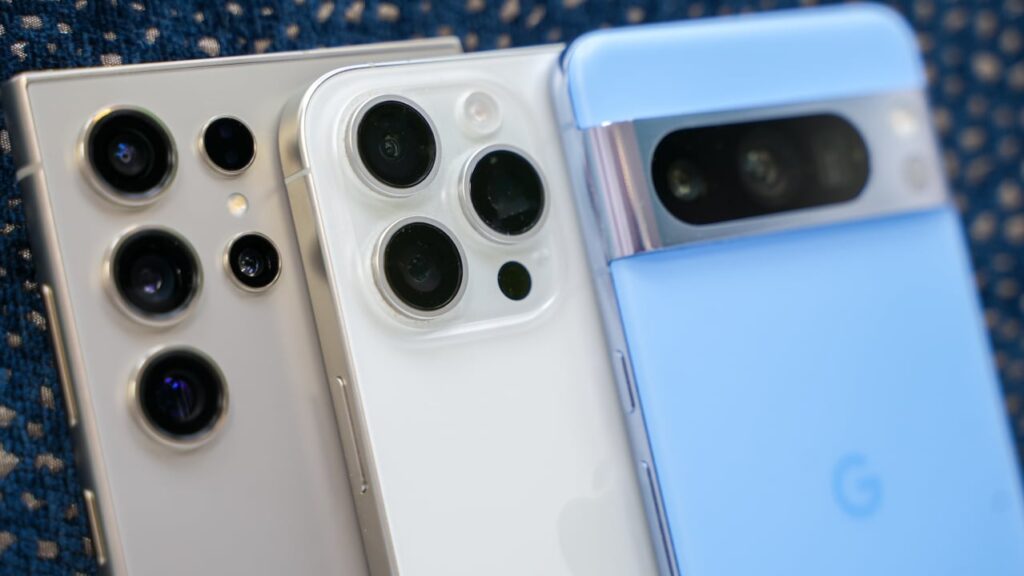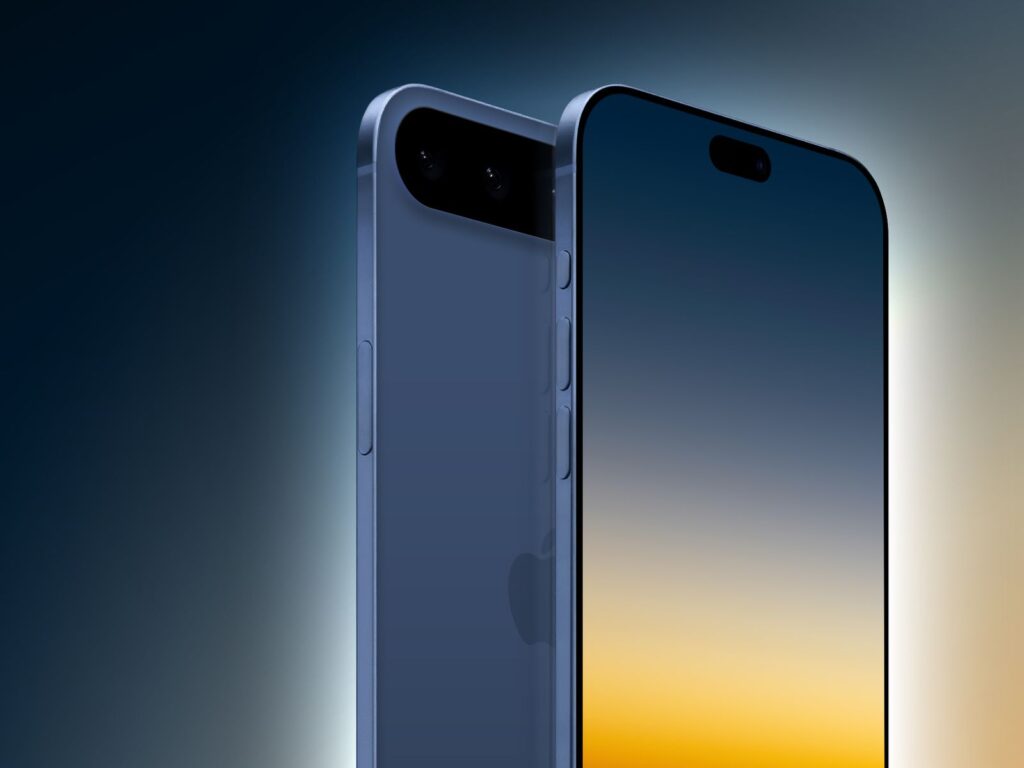Introduction — Nothing, But Different
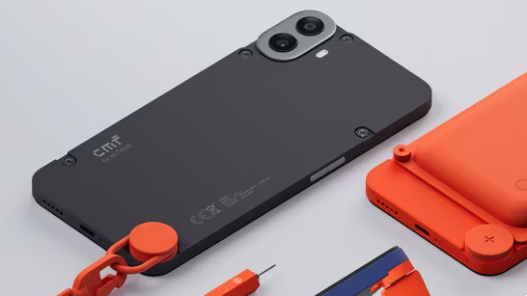
How Nothing Took the Smartphone World by Surprise
When Nothing launched its first phone, it wasn’t just another Android slab in a market full of similar-looking devices. In mid-2022, the Nothing Phone 1 arrived with a striking transparent design and an eye-catching Glyph Interface. It quickly carved a niche for itself as a phone that dared to be different. Within six months of its launch, Nothing had shipped over 500,000 units globally — a remarkable feat for a brand-new entrant in the cutthroat smartphone market.
What made tech enthusiasts and casual buyers stop and take notice was how Nothing packaged personality with practicality. While other brands obsessed over incremental camera upgrades or more megapixels, Nothing focused on design language and user experience. The company’s minimalist approach combined with clever marketing created a sense of hype that actually delivered.
The Philosophy Behind the Brand
Founded by Carl Pei, co-founder of OnePlus, Nothing was built around a simple yet bold philosophy: remove the clutter and bring back excitement to consumer tech. Pei believed smartphones had become dull, indistinguishable rectangles, and wanted to create devices people would feel emotionally connected to again.
The result? A transparent phone body revealing internal components, a custom LED-based Glyph Interface for notifications, and a stripped-down Android experience called Nothing OS. The idea was to make technology feel fun again without sacrificing functionality. Nothing’s branding thrives on clean aesthetics, quirky features, and the kind of design-led thinking typically reserved for luxury tech or concept hardware.
Nothing Phone 1 — The Transparent Trendsetter

Design and Glyph Interface Magic
The Nothing Phone 1 turned heads with its transparent back panel, offering a peek into the device’s internal components — a visual trick no mainstream Android phone had attempted before. The rear also housed 900 tiny LEDs forming the Glyph Interface, a customizable lighting system for calls, notifications, and charging indicators.
Beyond its novelty, the Glyph Interface proved genuinely useful. Users could assign custom light patterns to contacts or app alerts, adding a playful, futuristic touch to everyday interactions. This focus on personalization helped the Nothing Phone 1 distinguish itself in a sea of glass-backed clones.
Performance and Camera Experience
Powered by a Snapdragon 778G+ chipset and paired with up to 12GB RAM, the Nothing Phone 1 wasn’t a flagship killer in terms of raw specs. However, its clean, bloatware-free Nothing OS ensured snappy day-to-day performance.
The dual 50MP camera setup on the rear, featuring a Sony IMX766 primary sensor, delivered surprisingly good results in most lighting conditions. Low-light photography was a weak spot, but daylight shots offered sharp detail and balanced colors. Video performance was reliable, with 4K at 30fps and solid image stabilization.
How It Compared to Android Rivals in 2022
In 2022’s crowded mid-range market, the Nothing Phone 1 went head-to-head with devices like the Samsung Galaxy A53 and Google Pixel 6a. While those phones offered superior camera software or slightly better processors, the Phone 1’s design and Glyph Interface gave it an edge in user experience.
The clean Android build, free of bloatware and unnecessary skinning, outperformed many rivals in fluidity. Coupled with the 120Hz OLED display and unique notification system, the Nothing Phone 1 earned a reputation as one of the most enjoyable mid-tier Android phones of its time.
Where It Stands Today
Two years on, the Nothing Phone 1 still holds nostalgic appeal for tech enthusiasts. With regular software updates and a second-hand market price around $250, it remains a solid budget pick for those seeking a stylish, clean Android experience.
Its legacy paved the way for Nothing’s future releases, setting the tone for design-focused, personality-driven smartphones that refuse to blend into the Android crowd. Even as newer models arrive, the Nothing Phone 1’s bold debut ensures its place as a cult favorite in the Android space.
Nothing Phone 2 — Evolution or Hype?

Refined Glyph Interface and Performance Upgrades
Launched in mid-2023, the Nothing Phone 2 refined the design formula established by its predecessor. The Glyph Interface received an upgrade with more individually addressable LEDs, enabling richer light patterns and app-specific animations.
Under the hood, the Phone 2 switched to the Snapdragon 8+ Gen 1 processor, a flagship-grade chipset that delivered a noticeable boost in performance and gaming stability. Coupled with 12GB RAM and a 120Hz LTPO OLED display, this model offered an experience far closer to premium Android phones.
Is the Hype Justified?
At launch, critics debated whether Nothing was still riding on aesthetic novelty rather than real innovation. However, reviews praised the Phone 2’s software polish, haptic feedback, and camera improvements. Its Glyph Interface went beyond gimmick status, integrating with apps like Uber and Zomato to provide real-time progress indicators.
The overall verdict: hype justified. The Nothing Phone 2 matured into a credible alternative to upper mid-range devices.
Beating Mid-Range Android Options
Competing directly with the likes of the Pixel 7, OnePlus 11R, and Samsung Galaxy S23 FE, the Phone 2 stood out with its minimalist design, bloat-free Android skin, and a unique notification system. Benchmark scores placed it well ahead of its Snapdragon 7-series rivals, and its Glyph Interface gave it a lifestyle edge no other phone offered.
Battery, Display, and Real-World Use
Armed with a 4700mAh battery and 45W fast charging, the Phone 2 easily handled a full day’s use. Its LTPO OLED screen balanced a sharp 1080p resolution with adaptive refresh rates for energy efficiency. In daily use, its haptics, clean software, and striking design made it one of 2023’s most satisfying Android phones.
Nothing Phone 2a — Budget-Friendly Brilliance
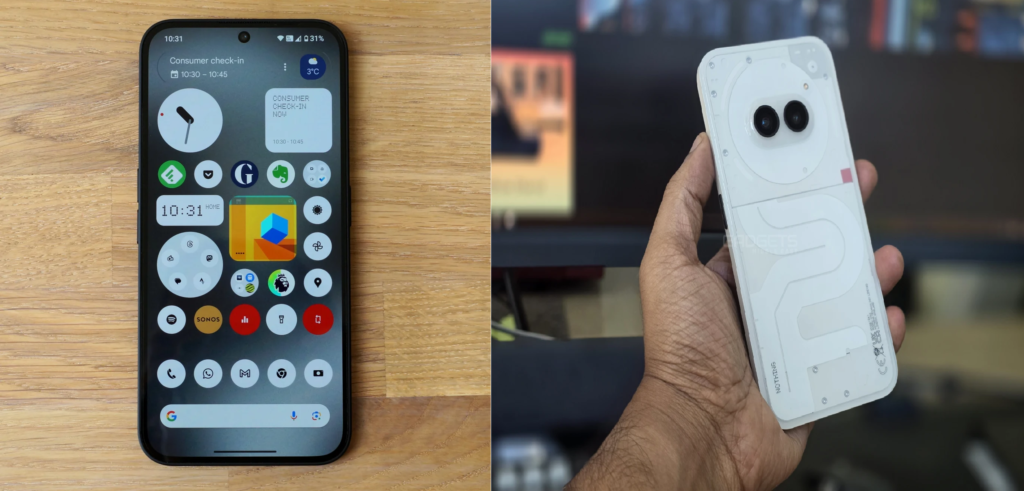
Standout Features at a Lower Price
The Nothing Phone 2a arrived in early 2024, aimed squarely at budget-conscious buyers. Stripping back some premium features but retaining core design elements, it offered a transparent back and simplified Glyph Interface.
Equipped with a MediaTek Dimensity 7200 Pro processor, a 120Hz AMOLED display, and dual 50MP cameras, it delivered strong specs for its price range.
Glyph Interface on a Budget
While scaled down, the 2a’s Glyph Interface remained functional, offering custom light patterns for calls, notifications, and charging. It maintained the signature design DNA of the Nothing Phones at a more affordable level.
How It Fares Against Samsung A Series and Pixel 7a
Pitted against devices like the Samsung Galaxy A35 and Pixel 7a, the Nothing Phone 2a impressed with its unique design, faster charging, and clean Android software. While its camera processing wasn’t as refined as Google’s, it outperformed Samsung’s A series in real-world speed tests and battery efficiency.
Value Verdict
At around $349, the Phone 2a proved exceptional value, bringing Nothing’s design-first philosophy to a wider audience. It remains one of the few budget phones that looks and feels premium.
Nothing Phone 3 — Where Premium Meets Personality

Enhanced Glyph Interface and Zoom Camera
The Nothing Phone 3, launched in 2025, took the brand’s concept to flagship levels. Featuring an upgraded Glyph Interface with advanced animations, it added new light-based features like caller priority and real-time delivery tracking.
Notably, it introduced a dedicated zoom camera for the first time — a 50MP telephoto lens, significantly improving Nothing’s photographic versatility.
Battery Life and Daily Performance
Powered by the Snapdragon 8 Gen 3, a 5000mAh battery, and a 6.7-inch LTPO AMOLED display, the Phone 3 delivered top-tier performance. The battery comfortably lasted 1.5 days with heavy use, while its adaptive refresh rate and clean Android skin ensured smooth, lag-free operation.
Competing with the iPhone 15 and Samsung Galaxy S24
With its polished build, unique design, and strong daily performance, the Phone 3 positioned itself as a genuine competitor to the iPhone 15 and Galaxy S24. It lacked some ecosystem perks, but its superior customization, open software, and Glyph Interface functionality gave it a distinctive edge.
Is It Finally a Flagship Killer?
By refining its hardware, enhancing its software, and expanding its feature set, the Nothing Phone 3 made a compelling flagship case. While it didn’t unseat giants like Samsung and Apple, it proved Nothing could comfortably play in the premium space while maintaining its bold, different DNA.
Nothing Phone 3a Pro — The Unexpected Surprise
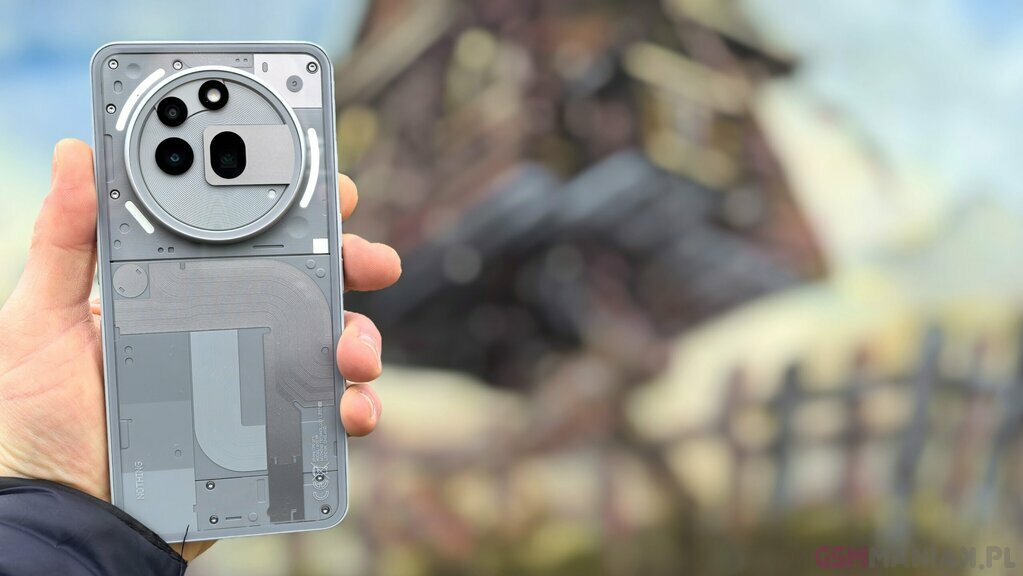
Real Zoom Camera in a Mid-Tier Device
The Nothing Phone 3a Pro surprised fans in early 2025 by introducing a dedicated 3x zoom telephoto lens in a phone priced under $600. This addition set it apart from most mid-tier devices, which typically rely on digital zoom or macro sensors.
Long Battery Life and Android Clean Experience
Boasting a 5100mAh battery, the 3a Pro comfortably stretched beyond a full day’s use, even with the always-on Glyph Interface. Its clean Android build, free of bloatware, combined with Nothing OS optimizations, made everyday performance consistently smooth.
Why It Outshines Other Mid-Range Phones
Competing mid-range Android phones often compromise on camera versatility or design innovation. The Phone 3a Pro, however, combined a reliable zoom lens, striking design, and extended battery life, making it one of the most distinctive options in its segment.
Perfect for Everyday Users?
For users valuing good cameras, long battery, and a clutter-free interface, the Nothing Phone 3a Pro delivered on all fronts. Its price-to-performance ratio and flagship-like features at a mid-range price point made it a standout recommendation.
How Nothing Phones Are Changing the Android Game
The Glyph Interface Concept: Gimmick or Genius?
Once dismissed as a flashy gimmick, the Glyph Interface evolved into a genuinely useful feature. By integrating practical notifications, app alerts, and progress indicators into the LED matrix, Nothing turned visual customization into functional utility.
Consistent Software Support and Clean Android
Unlike many Android brands, Nothing Phones offer consistent updates and a clean, near-stock Android experience. This approach appeals to users tired of bloatware-heavy skins and sporadic update schedules.
Design Innovation vs Bland Android Phones
In a world of indistinguishable slabs, Nothing Phones stand out with their transparent backs, symmetrical layouts, and playful LED elements. The brand’s design-led philosophy sets a refreshing precedent in a market obsessed with spec sheets.
Competitive Pricing and Feature Balance
Perhaps the most disruptive element is Nothing’s aggressive pricing. By delivering design-driven, feature-rich phones at competitive rates, Nothing challenges both budget and flagship Android segments, forcing rivals to rethink value propositions.
Nothing Phones vs iPhone: Can They Really Compete?
| Feature | Nothing Phones (Phone 3/2a) | iPhone (15/15 Pro) |
|---|---|---|
| Customization | Advanced (Glyph Interface, icon theming, home layouts) | Limited (widgets, focus modes only) |
| Ecosystem Flexibility | Open (supports sideloading, wide accessory support) | Closed (tightly integrated, proprietary) |
| Price Range | $349 – $649 | $799 – $1199 |
| Performance Chipset | Snapdragon 8 Gen 3 / Dimensity 7200 Pro | Apple A16 / A17 Bionic |
| Display | LTPO OLED, 120Hz adaptive refresh | OLED Super Retina XDR, 60-120Hz |
| Camera Hardware | Dual/Triple cameras, dedicated telephoto (Phone 3/3a Pro) | Dual/Triple with software processing |
| Battery Life | 1.5 days average (5000mAh) | 1 day average (3279-4323mAh) |
| Software Experience | Nothing OS (bloat-free, fast updates) | iOS (polished, but restrictive) |
| Unique Features | Glyph Interface, transparent design, open app support | Dynamic Island, AirDrop, Face ID |
Customization and Personalization Advantages
Nothing Phones offer a level of device personalization Apple’s iPhone line has historically resisted. The Glyph Interface transforms notifications and interactions into visual light cues, while the transparent back and app-specific light patterns add character. In contrast, iPhones largely rely on static lock screen widgets and limited theme controls.
Nothing OS also allows deeper home screen customization, icon theming, and haptic settings, appealing to Android users who crave control over their device’s look and feel.
Open Ecosystem vs Walled Garden
One of the biggest differences lies in ecosystem flexibility. While iPhones are tightly integrated within Apple’s proprietary ecosystem, Nothing Phones leverage Android’s openness. This means easier file transfers, broader third-party accessory compatibility, and native support for sideloaded apps — freedoms iPhone users often lack.
For users who value cross-device compatibility and app diversity, Nothing Phones offer a refreshing alternative to Apple’s walled garden.
Price-to-Performance Ratio
Nothing consistently undercuts Apple on price while delivering competitive performance. The Nothing Phone 3, with its Snapdragon 8 Gen 3 chipset and LTPO OLED display, launched at under $650 — several hundred dollars less than an entry-level iPhone 15. Even the Nothing Phone 2a, priced around $349, delivers impressive specs that rival mid-tier iPhones in real-world performance tests.
This aggressive pricing strategy allows Nothing to challenge Apple’s value proposition, especially in markets where premium pricing limits iPhone adoption.
Unique Design Language
While Apple’s hardware aesthetic has remained largely unchanged since the iPhone X, Nothing Phones push bold, design-first thinking. Their transparent backs, symmetrical layouts, and playful LED Glyph Interfaces make them instantly recognizable.
For users seeking standout hardware and personality, Nothing’s devices fill a design void left by increasingly homogenous smartphone competitors.
Final Verdict — Is a Nothing Phone Worth It in 2025?
Who Should Buy One?
A Nothing Phone makes the most sense for Android enthusiasts craving clean software, thoughtful design, and distinctive features at reasonable prices. It’s ideal for:
- Users frustrated by bloatware-heavy Android skins.
- Buyers prioritizing device personality and customizability.
- Value-seekers looking for flagship-level performance without Apple’s pricing.
- Tech lovers eager for something genuinely different.
What to Expect from Future Models
Given Nothing’s consistent evolution — from the Phone 1’s novelty to the Phone 3’s premium versatility — future models are likely to further refine the Glyph Interface and expand their camera capabilities. Rumors suggest possible foldables or wearables integrating with Nothing OS, maintaining the brand’s design-centric, minimal aesthetic.
Nothing has also promised extended software support and enhanced ecosystem features to strengthen its position against traditional flagships.
The Legacy of Nothing So Far
In just three years, Nothing Phones have reshaped expectations for Android smartphones. By prioritizing aesthetics, clean software, and user-centric features, they’ve carved out a meaningful space in a market dominated by spec wars.
More than a gimmick brand, Nothing’s steady growth, clever hardware choices, and disruptive pricing signal a new way forward for independent smartphone makers. Whether you’re after mid-range value or near-flagship power, a Nothing Phone in 2025 stands as one of the boldest and most original choices in the Android world.
FAQs
Are Nothing Phones better than iPhones in 2025?
It depends on what you value most. If you prefer customization, a clean Android experience, and unique design features like the Glyph Interface, Nothing Phones offer advantages over iPhones — especially at a lower price. However, iPhones still lead in ecosystem integration, long-term software support, and camera software optimization. In short: Nothing Phones win on style, personalization, and value, while iPhones maintain an edge in ecosystem perks and polish.
What makes the Glyph Interface on Nothing Phones so special?
The Glyph Interface is a standout feature exclusive to Nothing Phones. It uses LED lights on the back of the device to visually notify you of calls, app alerts, charging progress, and even delivery updates. It’s not just for show — the Glyph Interface adds real, functional value by letting you see important updates without picking up your phone, and it’s fully customizable per contact or app.
Which Nothing Phone is best for budget buyers in 2025?
The Nothing Phone 2a is the best pick for budget-conscious buyers in 2025. Priced around $349, it retains the brand’s signature transparent design and a simplified Glyph Interface, while offering solid performance with a Dimensity 7200 Pro processor and dual 50MP cameras. It competes directly with mid-tier options like the Samsung A35 and Pixel 7a — and often beats them in design, battery life, and real-world speed.

